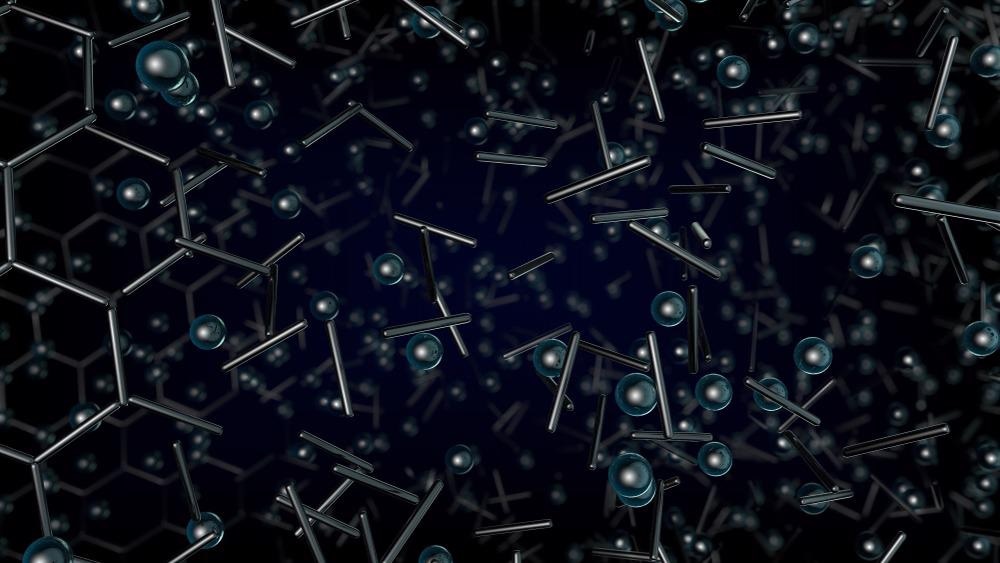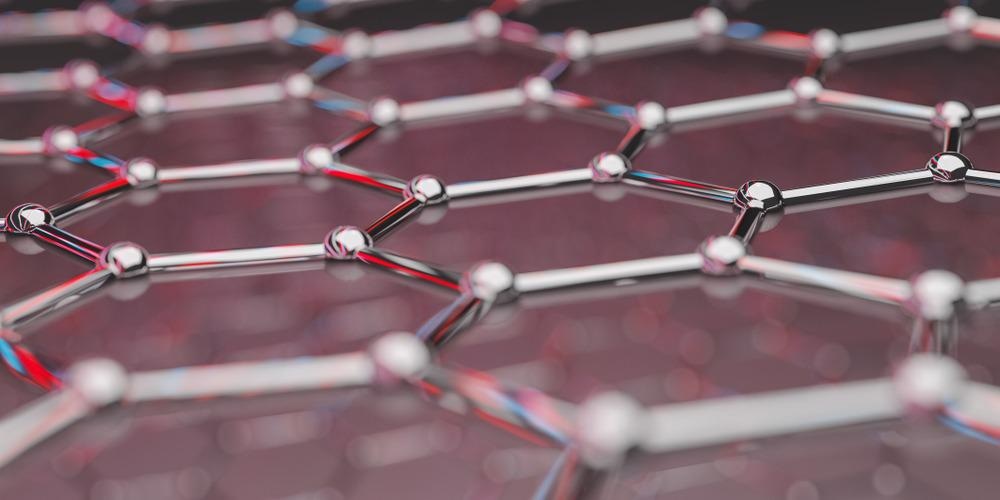Graphene is currently synthesized in two forms: powder or dispersion by top-down approach and continuous sheet graphene by a bottom-up approach. This article aims to provide insights into the synthesis of graphene via a bottom-up approach and the recent progress toward the commercialization of graphene films.

Image Credit: 3DStach/Shutterstock.com
Graphene Synthesis by Chemical Vapour Deposition
In bottom-up fabrication, sheet graphene is grown on a metal substrate such as copper or nickel foil by heating hydrocarbon gases such as methane at around 1000°C. The metal substrate acts as a catalyst, assisting in the separation of hydrogen from carbon. Carbon atoms then land on the metal substrate and self-assemble to form the graphene layer. This process is called chemical vapor deposition (CVD).
The CVD process can be carried out at low pressure (0.1 Torr) or at ambient pressure, and both have been used in pilot lines for industrial graphene production. To prevent the graphene from breaking during transfer, it is covered with a polymer film that is removed after the graphene film has been transferred to the target substrate.
Roll to Roll Production of Continuous sheet of Graphene
Roll to roll production is a disciplined approach to mass-producing continuous sheets of graphene. In this system, the graphene is grown by CVD technique on the foil moving through the roll-to-roll conveyor to form a single or multi-layer continuous sheet.
US-based CVD graphene developer General Graphene Corporation is one of the world's leading manufacturers and suppliers of continuous sheet roll-to-roll graphene at atmospheric pressure. Last year, it launched its new Gen3.0 CVD graphene production line. The company has developed a 20-meter-long roll-to-roll system that can produce single and multi-layer graphene at a manufacturing capacity exceeding 100,000 meters square per year.
In 2019 AIXTRON, with the support of Graphene Flagship, announced the launch of Neutron, a new roll-to-roll system capable of depositing large areas of graphene on metal foils under ambient conditions and with an annual production capacity of up to 20,000 square meters.
Recent Development in Graphene Transfer Techniques
After graphene growth, it is often desirable to transfer Graphene from its original growth substrate onto the desired substrate. The current state of the art is to use an etchant to etch the metal and then wet transfer the Graphene to the desired substrate. However, after graphene transfer, wrinkles, cracks, and contamination are observed, degrading the Graphene's quality. As a result, significant progress has been made in research aimed at achieving application quality transfer of defect-free graphene at a low cost.
For example, recently, researchers from the Chalmers University of Technology reported the development of a low-cost novel method for transferring graphene on affordable PET lamination foil by using an ordinary office laminator. The transferred graphene reached carrier mobility 6000-8000 cm2/V s at room temperature.
However, high-quality industrial-scale transfer is important to meet market demand for large-scale graphene applications. To achieve this, the roll-to-roll graphene transfer is developed. The process is fast, controllable, avoid chemical contamination of graphene film and can transfer graphene on any flexible substrates.
However, what if it is possible to grow high purity graphene without the need for a transfer process. In this regard, scientists from the UK-based graphene developer company Paragraf recently announced that they had solved the scalability problem by growing CVD graphene directly onto a semiconductor wafer, allowing them to grow high purity graphene without the need for a transfer process.

Image Credit: Production Perig/Shutterstock.com
Top Global Manufacturers and Suppliers of CVD Graphene
Among companies actively engaged in CVD graphene production are General Graphene Corporation and Graphene Laboratories Inc. in USA, Graphenea in Spain and Graphene Square and Charmgraphene in South Korea, Wuxi Graphene Films Ltd, 2D Carbon (Changzhou) Tech. Inc. Ltd, and Chongqing Graphene Technology Co. Ltd in China, BGT Materials Ltd in the UK has been working on large-scale manufacturing of high-quality sheet graphene.
In 2017, Graphenea announced that it would be able to produce 7000 wafers of CVD graphene per year with a wafer size of up to 8 inches.
Graphene Square manufactures graphene films on copper with a size of up to 5 × 5 cm2. They also provide custom-sized graphene films on PET with a surface area of 100 × 100 cm2. Charmgraphene announced they have doubled the speed to two meters per minute and can manufacture in lengths up to one kilometer.
Chongqing Graphene Technology, Wuxi Graphene Films, Changzhou 2D Carbon have announced that their annual production capacities for graphene film on Cu foil are 1 000 000 m2, 100 000 m2, and 150 000 m2, respectively, and all can provide graphene films with sizes of up to 300 × 30 cm2 on Cu foil or PET film.
BGT Materials provides graphene film on various substrates, including Cu, SiO2 and PET with sizes in the range of 1 × 1 to 60 × 762 cm2.
Single Crystal Graphene-Importance and the Recent Development
Until now, all of the companies above have been able to produce large sheets of graphene that are still polycrystalline and contain defects, thereby affecting the application of electronics devices. Recent developments, however, have demonstrated that it is possible to produce a square centimeter-scale near-perfect sheet of graphene on copper with no defects; this is known as single-crystal graphene.
Researchers from Perking University in China have reported the synthesis of a single crystal graphene film with a dimension of 5×5 cm2 on industrial copper foil. Similarly, UNIST researchers in South Korea reported a single crystal large area wrinkle-free graphene monolayer with dimensions of 4 ×7 cm2 on Cu–Ni (111) foils. Scientists from KAUST reported producing 5 cm diameter wafer-scale single-crystal graphene sheets on electrically insulating supports.
This development could promote the development of next-generation solar cell, wearable electronics, flexible touchscreens, and, most importantly, the space elevator. However, this recent advancement can only produce single-crystal graphene in a relatively small area, and thus there is still a long way to go before it can be used in real applications.
Commercial Applications of Large Area CVD Graphene
Graphene combines flexibility with conductivity, making it an obvious choice for ITO replacement. Researchers from Queen Mary University in collaboration with Paragraf™, developed the world's first CVD Graphene-OLEDs technology that can replace ITO in electronics devices.
Graphene Kitchen Styler is a new cooking appliance concept developed by Graphene Square Inc. that uses CVD graphene to heat and cook food. The device is completely foldable and is capable of precisely tracking the toasting level of the bread, consuming 50% less energy.
General Graphene Corp. is working on commercializing graphene as a high-performance heating material.
In healthcare, Grapheal, a French company, has developed an innovative graphene-based wearable patch for remote monitoring of chronic wounds. Grolltex is a CVD graphene manufacturer based in the United States has developed a graphene biosensor for the detection of SARS-CoV-2.
Future Perspective
The last few years have seen a lot of progress in the controllable synthesis, mass production, and new applications of CVD graphene films towards real commercialization. This would eventually aid in the development of the entire graphene industry.
CVD graphene films have gradually evolved into the major building block of the graphene industry, and this trend is expected to accelerate in the coming years.
Continue reading: A Top-Down Approach To Graphene Synthesis
References and Further Reading
Zhu, Y., et al. (2018). Mass production and industrial applications of graphene materials. National Science Review, 5(1), 90-101.
Wang, M., et al. (2021). Single-crystal, large-area, fold-free monolayer graphene. Nature, 596(7873), 519-524.
Xu, X., et al. (2017). Ultrafast epitaxial growth of metre-sized single-crystal graphene on industrial Cu foil. Science bulletin, 62(15), 1074-1080.
Li, J., et al. (2022). Wafer-scale single-crystal monolayer graphene grown on sapphire substrate. Nature Materials, 1-8.
General Graphene Corp. (2021) Roll to Roll Graphene Production. [online] generalgraphenecorp.com Available at https://generalgraphenecorp.com/technology/#our-graphene
Charmgraphene (2020) Roll to roll CVD graphene films. [online] http://charmgraphene.com/e-main.php Available at http://charmgraphene.com/bbs/board.php?bo_table=e_gp01_film&wr_id=1
BGT Materials (2013) CVD graphene. [online] bgtmaterials.com Available at https://bgtmaterials.com/products_grat_filmtm.php
Graphene Square (2012) CVD Graphene Films. [online] graphenesquare.com Available at http://www.graphenesq.com/products/product_list.asp?p_cate1=610&smenu=2
AIXTRON (2019) Neutron Roll to Roll CVD. [online] aixtron.com Available at https://www.aixtron.com/
ParagrafTM (2020) Graphene Hall Sensors. [online] https://www.paragraf.com/ Available at https://www.paragraf.com/graphene-electronics/ghs/
Graphenea (2010). Graphene products. [online] graphenea.com Available at: https://www.graphenea.com
Changzhou 2D Carbon (2014) CVD Graphene on Copper. [online] http://www.cz2dcarbon.com/en/ Available at http://www.cz2dcarbon.com/en/product/2016-5-10/121.html
Disclaimer: The views expressed here are those of the author expressed in their private capacity and do not necessarily represent the views of AZoM.com Limited T/A AZoNetwork the owner and operator of this website. This disclaimer forms part of the Terms and conditions of use of this website.